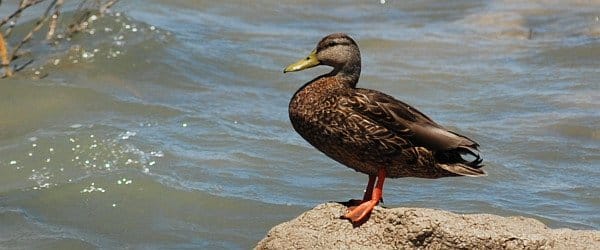When the American Ornithologists’ Union publishes its annual North American checklist update next month, many birders will be disappointed to see that a proposal to re-split Mexican Duck (Anas diazi) from Mallard (Anas platyrhynchos) has failed. The Mexican Duck, as its name suggests, is native to Mexico and parts of the southwestern United States, and unlike the Mallard, the Mexican Duck does not have a showy male breeding plumage; both sexes are brown throughout the year. Once considered a separate species, the Mexican Duck was lumped with Mallard in 1983 after studies indicated a high degree of hybridization, and that is where it’s remained ever since.

This male dabbler at Lake Balmorhea, Texas, shows many plumage features consistent with Mexican Duck, but curled black uppertail coverts suggest some Mallard ancestry. © David J. Ringer
Advocates for re-splitting the Mexican Duck cite a decade or so of genetic work that suggests Mexican Ducks are more closely related to Mottled Ducks and American Black Ducks than they are to Mallards. Some also take issue with the older phenotypical studies that purported to show massive hybridization by intergradation in plumage. For more on all this, see the AOU proposal (PDF) and my extensive post from last year.
But arguments made against the proposal include the following:
- Genetic sampling of Mexican Ducks has been insufficient to give an adequate understanding of the situation.
- Even if Mexican Duck is sister to Mottled Duck, it could still be considered conspecific with a more distantly related species if there are insufficient barriers to gene flow.
- Previous inferences about hybridization based on plumage characteristics cannot be discarded without a satisfactory explanation.
For more detail, you can read the comments on the AOU votes page. Some committee members found these arguments compelling and changed their votes.
One question at the heart of this debate is how these four populations (Mallard, American Black, Mottled, and Mexican Ducks) came to occur in North America. A hypothesis by some genetic researchers states that the green-headed Mallard arrived in North America after a prior colonization that had given rise to the other three species. But at least one AOU committee member has argued that the data so far can’t rule out the opposite scenario — that the Mallard split off from a North American population and subsequently invaded Eurasia.
That’s all fascinating from a historical and biogeographical perspective, but how much bearing should our understanding of the past have on our taxonomic treatment of populations in the present? Let’s assume for a moment that there is currently extensive gene flow going on between Mexican Ducks and Mallards. Whether that’s happening because they never fully diverged as populations or because they came into contact and had no (or weak) reproductive barriers, isn’t the effect (and therefore our taxonomic treatment) largely the same?
It’s clear we still have much to learn about these birds, and the AOU committee calls for “modern investigation of the nature of the contact zone between the two taxa.” In a case like this, it’s not really a surprise that the AOU would defer, prefering to maintain the status quo until stronger evidence can be obtained.
What do you think? Do you prefer stability and certainty, or would you rather make changes to our lists early and often? And while we’re at it, what’s your experience with Mexican Ducks and Mallards in Mexico, Arizona, New Mexico, and Texas?











Leave a Comment